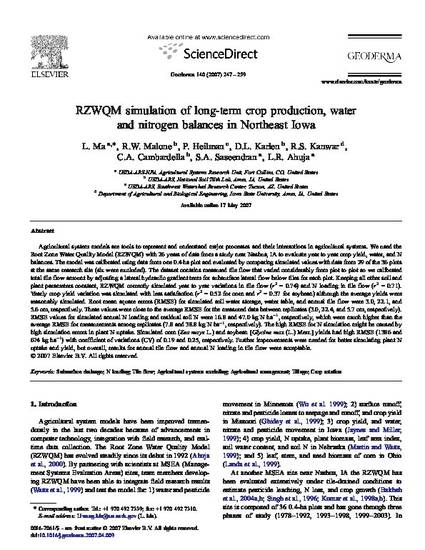
Agricultural system models are tools to represent and understand major processes and their interactions in agricultural systems. We used the Root Zone Water Quality Model (RZWQM) with 26 years of data from a study near Nashua, IA to evaluate year to year crop yield, water, and N balances. The model was calibrated using data from one 0.4 ha plot and evaluated by comparing simulated values with data from 29 of the 36 plots at the same research site (six were excluded). The dataset contains measured tile flow that varied considerably from plot to plot so we calibrated total tile flow amount by adjusting a lateral hydraulic gradient term for subsurface lateral flow below tiles for each plot. Keeping all other soil and plant parameters constant, RZWQM correctly simulated year to year variations in tile flow (r2 = 0.74) and N loading in tile flow (r2 = 0.71). Yearly crop yield variation was simulated with less satisfaction (r2 = 0.52 for corn and r2 = 0.37 for soybean) although the average yields were reasonably simulated. Root mean square errors (RMSE) for simulated soil water storage, water table, and annual tile flow were 3.0, 22.1, and 5.6 cm, respectively. These values were close to the average RMSE for the measured data between replicates (3.0, 22.4, and 5.7 cm, respectively). RMSE values for simulated annual N loading and residual soil N were 16.8 and 47.0 kg N ha−1, respectively, which were much higher than the average RMSE for measurements among replicates (7.8 and 38.8 kg N ha−1, respectively). The high RMSE for N simulation might be caused by high simulation errors in plant N uptake. Simulated corn (Zea mays L.) and soybean [Glycine max (L.) Merr.] yields had high RMSE (1386 and 674 kg ha−1) with coefficient of variations (CV) of 0.19 and 0.25, respectively. Further improvements were needed for better simulating plant N uptake and yield, but overall, results for annual tile flow and annual N loading in tile flow were acceptable.
Available at: http://works.bepress.com/douglas_karlen/23/

This article is from Geoderma 140 (2007): 247–259, doi:10.1016/j.geoderma.2007.04.009.